photo by Aleksandar Kostic
The US musician Joan La Barbara can be rightly considered to be the voice of new music. Blurring the line between composer and performer, La Barbara has redrawn the parameters of what the human voice is capable of. Coming out of a classical training, she has worked with many of the most significant names in the past 50 years of new music: David Tudor and Morton Feldman to Philip Glass and Steve Reich. La Barbara is an expert performer and interpreter of John Cage, who wrote his Solo for Voice 45 for her. Born in 1947, La Barbara headlines 2017’s London Contemporary Music Festival this Sunday, 10 December.
You had a conventional voice training. What led you to new music?
Joan La Barbara: I was trained as a lyric soprano but part of this training had to do with listening. I found myself listening to a lot of musicians who were experimental when it came to their instruments, but no one was doing anything radically experimental with voices. Cathy Berberian’s work was available and you could hear examples of rudimentary experimental vocal techniques on, for example, the Sequenza that Luciano Berio wrote for her – laughs, gasps, inhaled sounds – but I didn’t hear any extreme examples for voice. And I thought, well, this has to change. I started working with instrumentalists, teaching myself to imitate their sounds. When you study classical singing, you learn to control the voice in specific ways. One of the things I did was to manipulate the colour and timbre of tones and from there, I worked with improvised music, stretching the upper and lower registers of the voice. I was already drawn to working with sounds that did not yet exist within music.
Imitating other instruments got you some interesting openings.
JLB: Yes. Steve Reich hired me in 1970 to imitate the sound of bongo drums on the work that became Drumming. Then he decided that bongos suited his voice better and he asked me to be the marimba instead. I was singing the instrumental phases into the interlocking patterns that shifts the music along. I worked with Judith Sherman, Jay Clayton and Janice Jarrett on these vocals and what we did became part of the score. I started working with Philip Glass in 1972, when he was working on Music In Twelve Parts, I was originally singing a trumpet part and playing a keyboard. I said to him, “Yes, I can sing those two notes for 20 minutes, but…” The voice is essentially a muscular instrument and if you hold yourself in this way for 20 minutes, you are going to fatigue. Philip hadn’t thought out strategies for voice at that point.
What are extended vocals?
JLB: It’s the extreme use of the voice, not so much in terms of volume, but in expanding the resonating areas of the body. Think of the mask – that is, the front of the face – and then think outside that territory.
Any examples?
JLB: Well, there’s the vocal fry: it sounds like an egg frying. It’s actually an exhaled subtone, a growly sound that be trained so that it gives a more musical effect. The inhaled glottal click is the exhaled version of the fry, which tends to be more percussive and one can control the rate and speed of the clicking sound somewhat. You make a low tone, so your vocal cords are in a relaxed configuration and then take in a little air and a clicking sound emerges.
Your sonic palette has brought you to the attention of filmmakers. You’re the voice of the Newborn, the baby monster in the 1997 film, Alien: Resurrection, aren’t you?
JLB: I am! In terms of creating its voice, I looked at the structure of the Newborn’s head and saw that it had a huge resonating chamber – that’s very important in sound production. Also, while the baby monster had a long tongue, it had no lips. I had to eliminate any sounds that are formed with lips. I voiced the baby monster through inhaled glottal clicks and lots of other inhaled sounds. When the Newborn is sucked into space, it’s a very emotional scene. The director, Jean-Pierre Jeunet, and I spoke of Newborn’s death as an infanticide. He told me, “Don’t make the sounds too human.”
Of the three works that you’re performing on Sunday, one of them is the UK premiere of Erin, your 1980 work which is a soundscape of Ireland. Didn’t that have a recent film outing?
JLB: Yes, it gets a new life in Jóhann Jóhannsson’s Arrival. You hear it in three sections of the film, one of them being the language-teaching montage between the heptapods and the humans. It’s a happier alien film than the last one. Erin uses a bunch of extended vocal techniques: ululation, multiphonics, some imaginary languages I created. I’m also performing Solitary Journeys Of The Mind [2011], which is a real-time composition that uses a number of extended vocal techniques. It’s not a show-and-tell, it’s a musical exploration of sound.
And the third work on the programme is Windows (2013-17), which comes from your work-in-progress, an opera inspired by the artist Joseph Cornell and writer Virginia Woolf.
JLB: Windows is a sonic atmosphere of layers of voice and instruments with live vocals on top. Cornell used to travel from Queens into Manhattan on the elevated train and he liked looking into windows. He was definitely a voyeur, an observer of life rather than a participant in it. It’s an imaginative experience of lives taking place beyond what one knows.
Joan La Barbara headlines the Wild Pop event at the London Contemporary Music Festival this Sunday 10 December at 7pm. More details and tickets here.


